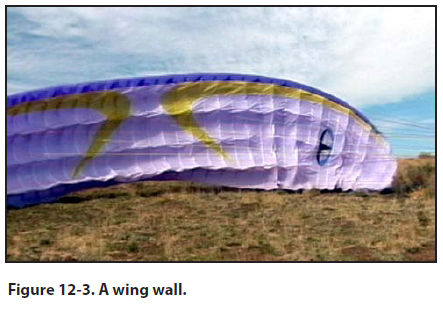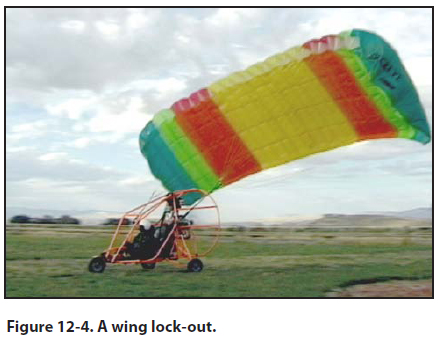|
Chapter 12 — Night, Abnormal, and Emergency Procedures
Restricted Lines During the
Takeoff Roll
If the lines (steering or suspension lines) become restricted,
such as around part of an outrigger, a trim
lock, or an accessory—then while safely maintaining
your ground direction into the wind and holding your
RPM down to kiting speed—reach out and push the
line off of the restricting object. If this is not possible,
then shut the PPC down and abort the takeoff.
To abort a takeoff (i.e., to shutdown) maintain your
ground steering clear of obstacles as you: (1) power
down the throttle, (2) push the magneto switches into
the OFF position, and (3) pull the wing down.
Entangled or Embedded Lines
If the lines become entangled or embedded with debris,
then shut the PPC down and clean up the lines.
If you don’t, and you load the wing by beginning the
lift-off, the stress on the lines as they pull through
the debris (twigs, sticks, and so forth) can break the
lines.
Lines Caught Under a Wheel
If the lines go under a wheel, IMMEDIATELY abort
the takeoff. Shut down: power, magnetos and wing
down.
A Wing Wall
The term “wall” is simply defined as the canopy literally
forming a wall-like appearance behind the PPC.
[Figure 12-3] The trailing edge of the canopy is still
on the ground, while the leading edge of the canopy
forms the top of the wall. The “wall” is the first canopy
problem that might occur during the initial kiting
of the wing.

Even though some pilots will try to “pop” the canopy
out of the “wall,” the only safe solution is to immediately
abort the takeoff, and re-layout the canopy. By
shutting down and restarting the takeoff preflight, pilots
will save the expense of many line and propeller
repairs. Lines will inevitably become damaged when
a pilot tries to “pop” the canopy out of the wall via
sharp throttle movements. When you fight the wall,
you create an ideal situation for lines to get sucked
into the propeller.
A Wing Lock-Out
A wing “lock-out” occurs when the initial forward
momentum is insufficient to move the canopy through
the prop-wash and up and above the PPC cart. [Figure
12-4] During this phenomenon, the inflated canopy
will hang at about a 45° angle behind the cart. This
is a “parachutal-wing stall” while the pilot is still on
the ground. Usually, regardless of how much groundspeed
is increased, the wing will stay in a parachutalwing
stall behind the cart as long as the tension on the
suspension lines remains the same; the wing will stay
“locked-out” in that 45° position.

There are two techniques that can be used to correct
this “parachutal-wing stall” position of a rectangular
wing:
1. Lower the groundspeed until the canopy begins
to fall down and back behind the cart. Then
before the wing touches the ground, smoothly
and firmly increase the groundspeed to move
(“sling-shot”) the canopy up and above the cart.
2. Maintain the groundspeed and pull the canopy
back via a flare (i.e., pushing both foot steering
bars). Hold the flare until the drag caused on the
tail of the wing pulls the wing back down—about
a 60° angle—
and then smoothly release the flare.
The release of the flare will again “sling-shot”
the canopy up and above the cart.
Note: Ask the advice of an instructor before using
these techniques on an elliptical-shaped wing. The
characteristics between the two types of PPC wings
are significant in correcting the “Locked-Out” scenario.
|

